Hanford Site
The Hanford Site is a decommissioned nuclear production complex operated by the United States federal government on the Columbia River in Benton County in the U.S. state of Washington. The site has been known by many names, including Site Wand the Hanford Nuclear Reservation. Established in 1943 as part of the Manhattan Project, the site was home to the Hanford Engineer Works and B Reactor, the first full-scale plutonium production reactor in the world. Plutonium manufactured at the site was used in the first atomic bomb, which was tested at the Trinity site, and in the Fat Man bomb that was detonated over Nagasaki, Japan.

During the Cold War, the project expanded to include nine nuclear reactors and five large plutonium processing complexes, which produced plutonium for most of the more than 60,000 weapons built for the U.S. nuclear arsenal. Nuclear technology developed rapidly during this period, and Hanford scientists produced major technological achievements. Many early safety procedures and waste disposal practices were inadequate, resulting in the release of significant amounts of radioactive materials into the air and the Columbia River.
The weapons production reactors were decommissioned at the end of the Cold War, and the Hanford Site became the focus of the nation's largest environmental cleanup. Besides the cleanup project, Hanford hosted a commercial nuclear power plant, the Columbia Generating Station, and various centers for scientific research and development, such as the Pacific Northwest National Laboratory, the Fast Flux Test Facility and the LIGO Hanford Observatory. In 2015 it was designated as part of the Manhattan Project National Historical Park.
Geography


The Hanford Site occupies 586 square miles (1,518 km2)—roughly equivalent to half of the total area of Rhode Island—within Benton County, Washington.[1][2] This land is closed to the general public. It is a desert environment receiving under 10 inches of annual precipitation, covered mostly by shrub-steppe vegetation. The Columbia River flows along the site for approximately 50 miles (80 km), forming its northern and eastern boundary.[3] The original site was 670 square miles (1,740 km2) and included buffer areas across the river in Grant and Franklin counties.[4] Some of this land has been returned to private use and is now covered with orchards, vineyards, and irrigated fields.[5]
In 2000, large portions of the site were turned over to the Hanford Reach National Monument.[6] The site is divided by function into three main areas. The nuclear reactors were located along the river in an area designated as the 100 Area; the chemical separations complexes were located inland in the Central Plateau, designated as the 200 Area; and various support facilities were located in the southeast corner of the site, designated as the 300 Area.[7] The site is bordered on the southeast by the Tri-Cities, a metropolitan area composed of Richland, Kennewick, Pasco, and smaller communities, and home to nearly 300,000 residents. Hanford is a primary economic base for these cities.[8] The Columbia and Yakima Rivers contain salmon, sturgeon, steelhead trout and bass, and wildlife in the area includes skunks, muskrats, coyotes, raccoons, deer, eagles, hawks and owls. The flora includes sagebrush, bitterbrush, a variety of grasses, prickly pear and willow.[9]
Climate
| Climate data for Hanford Site, Washington | |||||||||||||
|---|---|---|---|---|---|---|---|---|---|---|---|---|---|
| Month | Jan | Feb | Mar | Apr | May | Jun | Jul | Aug | Sep | Oct | Nov | Dec | Year |
| Record high °F (°C) | 65 (18) |
71 (22) |
87 (31) |
95 (35) |
103 (39) |
110 (43) |
115 (46) |
110 (43) |
101 (38) |
89 (32) |
73 (23) |
68 (20) |
115 (46) |
| Mean maximum °F (°C) | 56.7 (13.7) |
60.2 (15.7) |
73.1 (22.8) |
84.8 (29.3) |
93.4 (34.1) |
102.2 (39.0) |
107.6 (42.0) |
102.9 (39.4) |
94.0 (34.4) |
80.9 (27.2) |
64.4 (18.0) |
58.7 (14.8) |
107.9 (42.2) |
| Average high °F (°C) | 38.3 (3.5) |
45.8 (7.7) |
59.4 (15.2) |
68.7 (20.4) |
77.6 (25.3) |
85.6 (29.8) |
94.0 (34.4) |
91.1 (32.8) |
80.0 (26.7) |
66.7 (19.3) |
49.7 (9.8) |
39.8 (4.3) |
66.4 (19.1) |
| Average low °F (°C) | 22.1 (−5.5) |
26.0 (−3.3) |
32.4 (0.2) |
39.0 (3.9) |
46.2 (7.9) |
53.8 (12.1) |
59.0 (15.0) |
56.7 (13.7) |
48.5 (9.2) |
39.1 (3.9) |
29.6 (−1.3) |
24.3 (−4.3) |
39.7 (4.3) |
| Mean minimum °F (°C) | 5.1 (−14.9) |
11.2 (−11.6) |
20.5 (−6.4) |
26.2 (−3.2) |
33.5 (0.8) |
43.0 (6.1) |
48.3 (9.1) |
45.5 (7.5) |
36.5 (2.5) |
26.3 (−3.2) |
16.1 (−8.8) |
7.3 (−13.7) |
−2.8 (−19.3) |
| Record low °F (°C) | −22 (−30) |
−19 (−28) |
12 (−11) |
12 (−11) |
28 (−2) |
33 (1) |
41 (5) |
40 (4) |
25 (−4) |
17 (−8) |
0 (−18) |
−27 (−33) |
−27 (−33) |
| Average precipitation inches (mm) | 0.84 (21) |
0.57 (14) |
0.28 (7.1) |
0.42 (11) |
0.52 (13) |
0.58 (15) |
0.10 (2.5) |
0.19 (4.8) |
0.34 (8.6) |
0.56 (14) |
1.05 (27) |
0.91 (23) |
6.14 (156) |
| Average snowfall inches (cm) | 5.8 (15) |
3.7 (9.4) |
0.1 (0.25) |
0.0 (0.0) |
0.0 (0.0) |
0.0 (0.0) |
0.0 (0.0) |
0.0 (0.0) |
0.0 (0.0) |
0.0 (0.0) |
1.9 (4.8) |
4.4 (11) |
15.9 (40.45) |
| Source: [10] | |||||||||||||
Hanford is the site of Washington state's highest recorded temperature, which reached 120 °F (48.9 °C) on June 29, 2021.[11]
Early history
The confluence of the Yakima, Snake, and Columbia rivers has been a meeting place for native peoples for centuries. The archaeological record of Native American habitation of this area stretches back over ten thousand years. Tribes and nations including the Yakama, Nez Perce, and Umatilla used the area for hunting, fishing, and gathering plant foods.[12] Hanford archaeologists have identified numerous Native American sites, including "pit house villages, open campsites, fish farming sites, hunting/kill sites, game drive complexes, quarries, and spirit quest sites",[4] and two archaeological sites were listed on the National Register of Historic Places in 1976.[13] In 1855, Isaac Stevens, the governor of the Territory of Washington, negotiation with the Native American tribes to establish a reservation system. Treaties were signed, but were often ignored, as the reservation system was not compatible with to their traditional food-gathering or family groupings. In September 1858, a military expedition under Colonel George Wright defeated the Native American tribes in the Battle of Spokane Plains to force compliance with the reservation system.[14] Nonetheless, Native American use of the area continued into the 20th century. The Wanapum people were never forced onto a reservation, and they lived along the Columbia River in the Priest Rapids Valley until 1943.[4]
After gold was discovered in British Columbia, prospectors explored the Columbia River basin in search of gold, but with little success. Walla Walla, which had been established as a military post in 1858, became a center for mining supplies, and a general store was established at White Bluffs. A ranch was established in Yakima Valley by Ben Snipes in 1859, and the Northern Pacific Railroad was extended into the area, beginning in 1879. Railroad engineers founded the towns of Kennewick and Pasco. Settlers moved into the region, initially along the Columbia River south of Priest Rapids. They established farms and orchards supported by small-scale irrigation projects, but most went bankrupt in the Panic of 1893. The Reclamation Act of 1902 provided for federal government participation in the financing of irroigation projects, and the population began expanding again, with small town centers at Hanford, White Bluffs and Richland established between 1905 and 1910. The Great Depression of the 1930s drove the price of agricultural commodities down, and many farms were foreclosed or abandoned. The economy was supported by the construction of the Grand Coulee Dam between 1933 and 1942, and the establishment of the Naval Air Station Pasco in 1942.[15][16]
Manhattan Project
Contractor selection
During World War II, the S-1 Section of the federal Office of Scientific Research and Development (OSRD) sponsored a research project on plutonium. Research was conducted by scientists at the University of Chicago Metallurgical Laboratory. At the time, plutonium was a rare element that had only recently been synthesized in laboratories. It was theorized that plutonium was fissile and could be used in an atomic bomb. The United States government was concerned that Germany was developing a nuclear weapons program. The Metallurgical Laboratory physicists worked on designing nuclear reactors ("piles") that could irradiate uranium and transmute it into plutonium. Meanwhile chemists investigated ways to separate plutonium from uranium.[17]
In September 1942, Brigadier General Leslie R. Groves Jr. became the director of the Manhattan Project, as it came to be known.[18] The project to build industrial-size plants for the manufacture of plutonium was codenamed the X-10 project.[19] Groves engaged DuPont, a firm he had worked with in the past on the construction of explosives plants, to design, construct and operate the plutonium manufacturing complex.[20][21][22] To avoid being labeled as merchants of death, as the company had been after World War I, DuPont's executive committee insisted that it should receive no payment. For legal reasons, a Cost Plus Fixed Fee contract was agreed, with a fee of one dollar. The President of Dupont, Walter S. Carpenter Jr., was given assurances that the government was assuming all responsibility for the hazards involved in the project.[23][24]
Site selection
Carpenter expressed reservations about building the reactors at Oak Ridge, Tennessee, due to the proximity of Knoxville, which was 20 miles (32 km) away.[25] A catastrophic accident might result in loss of life and severe health effects. Even a less deadly accident might disrupt vital war production, particularly of aluminum, and force the evacuation of the Manhattan Project's isotope separation plants. But spreading the facilities at Oak Ridge out more would require the purchase of more land. Moreover, the number of reactors that needed to be built was still uncertain; for planning purpose it was intended to build six, along with four chemical separation plants.[26]
The ideal site was described by eight criteria:
- A clean and abundant water supply (at least 25,000 US gallons per minute (1,600 l/s))
- A large electric power supply (about 100,000 KW)
- A "hazardous manufacturing area" of at least 12 by 16 miles (19 by 26 km)
- Space for laboratory facilities at least 8 miles (13 km) from the nearest reactor or separations plant
- The employees' village no less than 10 miles (16 km) upwind of the plant
- No towns of more than 1,000 people closer than 20 miles (32 km) from the hazardous rectangle
- No main highway, railway, or employee village closer than 10 miles (16 km) from the hazardous rectangle
- Ground that could bear heavy loads.[27]
The most important of these criteria was the availability of electric power. The needs of war industries had created power shortages in many parts of the country, and use of the Tennessee Valley Authority was ruled out because the Clinton Engineer Works was expected to use up all of its surplus power. This led to consideration of alternative sites in the Pacific Northwest and Southwest, where there was surplus electrical power. Between December 18 and 31, 1942, just twelve days after the Met Lab team lead by Enrico Fermi started up Chicago Pile-1, the first nuclear reactor, a three-man party consisting of Colonel Franklin T. Matthias and DuPont engineers A. E. S. Hall and Gilbert P. Church inspected the most promising potential sites.[28][29][30][31] Matthias reported to Groves that the Hanford site was "far more favorable in virtually all respects than any other";[32] the survey party was particularly impressed by the fact that a high-voltage power line from Grand Coolee Dam to Bonneville Dam ran through the site, and there was an electrical substation on its edge. Groves visited the site on January 16, 1943, and approved the selection.[33] The facility became known as the Hanford Engineer Works (HEW), and the site was codenamed Site W.[34]
Land acquisition
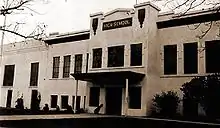
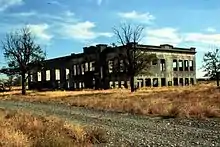
The Secretary of War, Henry L. Stimson, authorized the acquisition of the land on February 8, 1943.[33][35] A Manhattan District project office opened in Prosser, Washington, on February 22, and the Washington Title Insurance Company opened an office there to furnish title certificates. Federal Judge Lewis B. Schwellenbach issued an order of possession under the Second War Powers Act the following day, and the first tract was acquired on March 10.[35][36] In all, 4,218 tracts totaling 428,203.95 acres (173,287.99 ha) were to be acquired,[37] making it one of the largest land acquisition projects in American history.[38]
Most of the land (some 88 percent) was sagebrush, where eighteen to twenty thousand sheep grazed. About 11 percent was farmland, although not all was under cultivation.[39] Farmers felt that they should be compensated for the value of the crops they had planted as well as for the land itself.[40] Because construction plans had not yet been drawn up, and work on the site could not immediately commence, Groves decided to postpone the taking of the physical possession of properties under cultivation to allow farmers to harvest the crops they had already planted. This reduced the hardship on the farmers, and avoided the wasting of food at a time when the nation was facing food shortages and the federal government was urging citizens to plant victory gardens.[41][42] The War Department arranged with Federal Prison Industries for crops to be harvested by prisoners from the McNeil Island Penitentiary.[43][40]
The harvest in the spring and summer of 1943 was exceptionally good, and prices were high due to the war. This greatly increased the land prices that the government had to pay. It also promoted exaggerated ideas about the value of the land, leading to litigation.[41][42] Discontent over the acquisition was apparent in letters sent from Hanford site residents to the War and Justice Departments, and the Truman Committee began making inquiries.[44] Stimson then went to see the chairman of the committee, Senator Harry S. Truman, who agreed to remove the Hanford site from the committee's investigations on the grounds of national security.[45] Trial juries were sympathetic to the claims of the landowners and the payments awarded were well in excess of the government appraisals.[46] When the Manhattan Project ended on December 31, 1946, there were still 237 tracts remaining to be settled.[47]
About 1,500 residents of Hanford, White Bluffs, and nearby settlements were relocated, as well as the Wanapum people, Confederated Tribes and Bands of the Yakima Nation, the Confederated Tribes of the Umatilla Indian Reservation, and the Nez Perce Tribe.[48][49] Native Americans were accustomed to fishing in the Columbia River near White Bluffs for two or three weeks in October. The fish they caught was dried and provided food for the winter. They rejected offers of an annual cash payment, and a deal was struck allowing the chief and his two assistants to issue passes to fish at the site. This authority was later revoked for security reasons. Matthias gave assurances that Native American graves would be treated with respect, but it would be 15 years before the Wanapum people were allowed access to mark the cemetaries. In 1997, the elders were pemitted to bring children and young adults onto the site once a year to learn about their sacred sites.[50]
Construction
DuPont advertised for workers in newspapers for an unspecified "war construction project" in southeastern Washington, offering "attractive scale of wages" and living facilities.[51] Normally for a development in such a isolated area, employees would be accommodated on site, but in this case for security and safety reasons it was desirable to locate them at least 10 miles (16 km) away. Even the construction workforce could not be housed on site, because some plant operation would have to be carried out during startup testing. The Army and DuPont engineers decided to create two communities: a temporary constructions camp and a more substantial operating village. Construction was expedited by locating them on the sites of existing villages, where they could take advantage of the buildings, roads and utility infrastructure already in place. They established the construction camp on the site of the village of Hanford, and the operating village on that of Richland.[52]
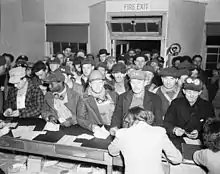
The construction workforce peaked reached a peak of 45,096 on 21 June 1944.[53] About thirteen percent were women, and non-whites made up 16.45 percent. African-Americans lived in segregated quarters, had their own messes and recreation areas,[54] and were paid less than white workers.[55] Three types of accommodation was provided at Hanford: barracks, hutments and trailer parking. The first workers to arrive lived in tents while they erected the first barracks. Barracks construction commenced on 6 April 1943 and eventually 195 barracks were erected: 110 for white men, 21 for black men, 57 for white women and seven for black women. Hutments were prefabricated plywood and Celotex dwellings capable of accommodating ten to twenty workers each. Between them, the barracks and hutments held 39,050 workers. Many workers had their own trailers, taking their families with them from one wartime construction job to the next. Seven trailer camps were established, and at the peak of construction work 12,008 people were living in them.[56][57]
DuPont put the contract for building the village of Richland out to tender, and the contract was awarded to the lowest bidder, G. Albin Pehrson, on 16 March 1943. Pehrson produced a series of standard house designs based on the Cape Cod and ranch-style house design fashions of the day.[58] Pehrson accepted the need for speed and efficiency, but his vision of a model late-20th century community differed from the austere concept of Groves. Pehrson ultimately had his way on most issues, because DuPont was his customer, not the Army.[58] The resulting compromise would handicap Richland for many years with inadequate sidewalks, stores and shops, no civic center, and roads that were too narrow.[59] Unlike Oak Ridge and Los Alamos, Richland was not surrounded by a high wire fence. Because it was open, Matthias asked DuPont to ensure that it was kept neat and tidy.[59]
Plutonium production

Construction of the nuclear facilities proceeded rapidly. Before the end of the war in August 1945, the HEW built 554 buildings at Hanford, including three nuclear reactors (105-B, 105-D, and 105-F) and three plutonium processing plants (221-T, 221-B, and 221-U).[32]T he project required 386 miles (621 km) of roads, 158 miles (254 km) of railway, and four electrical substations. The HEW used 780,000 cubic yards (600,000 m3) of concrete and 40,000 short tons (36,000 t) of structural steel.[60]
Uranium arrived at the Hanford Engineer Works in the form of billets. In the Metal Fabrication and Testing (500) Area they wereextruded into rods and machined into cylindrical pieces, 1.569 inches (3.99 cm) in diameter and 8 inches (20 cm) long, known as "slugs". The initial charge of the three reactors required more than twenty thousand billets, and another two thousand were required each month. Uranium was highly reactive with water,so to be protect them from corrosion by the cooling water they were canned in aluminum a molten bath of copper-tin alloy, and the cap was arc welded on. A defective can could burst and jam in the reactor, stop the flow of cooling water, and force a complete shutdown of the reactor, so the canning process had to be exacting.[61][62]
Construction on B Reactor commenced in August 1943 and was completed on September 13, 1944. The reactor went critical in late September and, after overcoming neutron poisoning, produced its first plutonium on November 6, 1944.[63] The reactors were graphite moderated and water cooled. They consisted of a 28-by-36-foot (8.5 by 11.0 m), 1,200-short-ton (1,100 t) graphite cylinder lying on its side, penetrated through its entire length horizontally by 2,004 aluminium tubes.[64] containing 200 short tons (180 t) of uranium slugs.[65] They had no moving parts; the only sounds were those of the water pumps.[66] Cooling water was pumped through the tubes at the rate of 30,000 US gallons (110,000 L) per minute.[64] This was enough water for a city of a million people.[67][68]
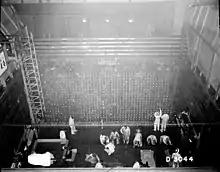
Although the reactors could be shut down in two and a half seconds, the decay of fission products meant that they would still generate heat due to the decay of fission products. It was therefore vital that the flow of water should not be cease.[67][68] If the power failed, the steam pumps would automatically cut in and continue to deliver water at full capacity for long enough allow an orderly shutdown.[69] This occurred on March 10, 1945, when a Japanese balloon bomb struck a high-tension line running between Grand Coolee and Bonneville. This caused an electrical surge in the lines to the reactors. A scram was automatically initiated and the safety devices shut the reactors down. The bomb failed to explode and the transmission line was not badly damaged.[70][71] The Hanford Engineer Works was the only US nuclear facility to come under enemy attack.[72]
Irradiated fuel slugs were transported by rail to huge remotely-operated chemical separation plants about 10 miles (16 km) away on a special railroad car operated by remote control.[73] The separation buildings were massive windowless concrete structures, 800 feet (240 m) long, 80 feet (24 m) high and 65 feet (20 m) wide, with concrete walls 3 to 5 feet (0.91 to 1.52 m) thick. Inside, the buildings were canyons and galleries where a series of chemical processing steps separated the small amount of plutonium from the remaining uranium and fission products.[74][75] Items were moved about with a 60-foot (18 m) long overhead crane. Once they began processing irradiated slugs, the machinery would become so radioactive that it would be unsafe for humans ever to come in contact with it, so the engineers devised methods to allow for the replacement of components via remote control.[76] Periscopes and closed-circuit television gave the operator a view of the process. They assembled the equipment by remote control as if the area was already radioactive.[76] To receive the radioactive wastes from the chemical separations process, there were "tank farms" consisting of 64 single-shell underground waste tanks.[77]
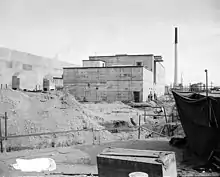
The first batch of plutonium was refined in the 221-T plant from December 26, 1944, to February 2, 1945, and delivered to the Los Alamos laboratory in New Mexico on February 5, 1945.[78] Two identical reactors, D Reactor and F reactor, came online in December 5, 1944, and February 15, 1945, respectively, and all three reactors were running at full power (250 megawatts) by March 8, 1945.[79] By April, trains containing kilogram quantity shipments of plutonium were headed to Los Alamos every five days. Road convoys replaced the trains in May, and in late July shipments began being despatched by air from the airport at Hanford.[80]
Hanford provided the material for the Fat Man bombs tested at Trinity and dropped over Nagasaki.[81] Throughout this period, the Manhattan Project maintained a top secret classification. Fewer than one percent of Hanford's workers knew they were working on a nuclear weapons project.[82] Groves noted in his memoirs that "We made certain that each member of the project thoroughly understood his part in the total effort; that, and nothing more."[83] The existence and purpose of Hanford was publicly revealed through press releases on 7 and 9 August 1945, after the bombing of Hiroshima but before Hanford plutonium in a Fat Man bomb was used in the bombing of Nagasaki on 9 August.[84]
Matthias was succeeded as area engineer by Colonel Frederick J. Clarke in January 1946.[85][86] DuPont would soon be gone too. Carpenter asked to be released from the contract.[87][88] Groves informed Patterson, who had succeeded Stimson as Secretary of War on 21 September 1945,[89] Groves's choice of replacement was General Electric,[90] which took over operations at Hanford on 1 September 1946, and accepted a formal control on 30 September.[87][88] On 31 December 1946, the Manhattan Project ended and control of the Hanford site passed to the Atomic Energy Commission.[91] The total cost of the Hanford Engineer Works up to that time was $348,101,240 (equivalent to $4,837,181,565 in 2021).[92]
Cold War expansion
General Electric inherited serious operational problems. Running the reactors continuously at full power had resulted in the Wigner effect, swelling of the graphite due to the displacement of the atoms in its crytaline structure by collisions with neutrons. This had the potential to buckle the aluminum tubes and disable the reactors. While plutonium-239 has a half life of 24,100 years, the polonium-210 used in the Fat Man's neutron initiators had a half life of only 138 days. It was therefore essential to keep a reactor running or the weapons would be rendered inoperable. The Army therefore shut down B Reactor and reduced the power lever on D and F Reactors to extend their useful life. The other problem was that the bismuth phospahte process used to separate the plutonium left the uranium in an unrevoverable state. The Metallurgical Laboratory had researched a promising new redox separation process, using hexone as a solvent.[93][94][95]
As the Cold War began, the United States faced a new strategic threat in the rise of the Soviet nuclear weapons program. In August 1947, the Hanford Works announced funding for the construction of two new weapons reactors and research to develop a new chemical separations process, entering a new phase of expansion.[96]
By 1963, the Hanford Site was home to nine nuclear reactors along the Columbia River, five reprocessing plants on the central plateau, and more than 900 support buildings and radiological laboratories around the site.[1] Extensive modifications and upgrades were made to the original three World War II reactors, and a total of 177 underground waste tanks were built.[1] Hanford was at its peak production from 1956 to 1965. Over the entire 40 years of operations, the site produced about 63 short tons (57 t) of plutonium, supplying the majority of the 60,000 weapons in the U.S. arsenal.[1][2] Uranium-233 was also produced.[97][98][99][100]
In 1976, a Hanford technician named Harold McCluskey received the largest recorded dose of americium following a laboratory accident. Due to prompt medical intervention, he survived the incident and died eleven years later of natural causes.[101]
Decommissioning

Most of the reactors were shut down between 1964 and 1971, with an average individual life span of 22 years. The last reactor, N Reactor, continued to operate as a dual-purpose reactor, being both a power reactor used to feed the civilian electrical grid via the Washington Public Power Supply System (WPPSS) and a plutonium production reactor for nuclear weapons. N Reactor operated until 1987. Since then, most of the Hanford reactors have been entombed ("cocooned") to allow the radioactive materials to decay, and the surrounding structures have been removed and buried.[102] The B-Reactor has not been cocooned and is accessible to the public on occasional guided tours. It was listed on the National Register of Historic Places in 1992,[103]
and some historians advocated converting it into a museum.[104][105] B reactor was designated a National Historic Landmark by the National Park Service on August 19, 2008.[106][107][108] On November 10, 2015, it was designated as part of the Manhattan Project National Historical Park alongside other sites in Oak Ridge and Los Alamos.[109]
| Reactor name | Start-up date | Shutdown date | Initial power (MWt) |
Final power (MWt) |
Interim safe storage status |
|---|---|---|---|---|---|
| B Reactor | Sep 1944 | Feb 1968 | 250 | 2210 | Not cocooned, hazards mitigation authorized 2001[111] |
| D Reactor | Dec 1944 | Jun 1967 | 250 | 2165 | 2004[112] |
| F Reactor | Feb 1945 | Jun 1965 | 250 | 2040 | 2003[113] |
| H Reactor | Oct 1949 | Apr 1965 | 400 | 2140 | 2005[114] |
| DR ("D Replacement") Reactor | Oct 1950 | Dec 1964 | 250 | 2015 | 2002[115] |
| C Reactor | Nov 1952 | Apr 1969 | 650 | 2500 | 1998[116] |
| KW ("K West") Reactor | Jan 1955 | Feb 1970 | 1800 | 4400 | Preliminary plans, January 30, 2018[117] |
| KE ("K East") Reactor | Apr 1955 | Jan 1971 | 1800 | 4400 | Preliminary plans, January 30, 2018[117] |
| N Reactor | Dec 1963 | Jan 1987 | 4000 | 4000 | 2012[118] |
Later operations
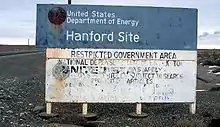
The United States Department of Energy assumed control of the Hanford Site in 1977. Although uranium enrichment and plutonium breeding were slowly phased out, the nuclear legacy left an indelible mark on the Tri-Cities. Since World War II, the area had developed from a small farming community to a booming "Atomic Frontier" to a powerhouse of the nuclear-industrial complex. Decades of federal investment created a community of highly skilled scientists and engineers. As a result of this concentration of specialized skills, the Hanford Site was able to diversify its operations to include scientific research, test facilities, and commercial nuclear power production.
As of 2013, operational facilities located at the Hanford Site included:
- The Pacific Northwest National Laboratory, owned by the Department of Energy and operated by Battelle Memorial Institute
- The Fast Flux Test Facility (FFTF), a national research facility in operation from 1980 to 1992 whose last fuel was removed in 2008[119]
- LIGO's Hanford Observatory, an interferometer searching for gravitational waves[120][121][122][123]
- Columbia Generating Station, a commercial nuclear power plant operated by Energy Northwest.
- A US Navy nuclear Ship-Submarine Recycling Program dry storage site containing sealed reactor sections of 114 US Navy ships as of 2008.[124]
The Department of Energy and its contractors offer tours of the site. The tours are free, can be reserved in advance via the department's web site, and are limited to U.S. citizens at least 18 years of age.[125][108] Between 2009 and 2018, approximately 80,000 people visited the site, bringing an estimated annual tourist income of two million dollars to the surrounding area.[108]
Tunnel collapse
On the morning of May 9, 2017, a twenty-foot (6 m) section of a 360-foot (110 m) tunnel caved in. It was used to store contaminated materials and was located next to the Plutonium Uranium Extraction (PUREX) Facility in the 200 East Area in the center of the Hanford Site. All non-essential personnel were placed under a take cover alarm on the site. Some 53 truckloads (about 550 cubic yards (420 m3)) of soil were used to fill in the hole.[126]
Environmental concerns
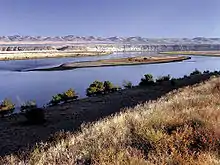
A huge volume of water from the Columbia River was required to dissipate the heat produced by Hanford's nuclear reactors. As much as 75,000 gallons per minute was diverted from the Columbia River to cool the reactor.[108]
From 1944 to 1971, pump systems drew cooling water from the river and, after treating this water for use by the reactors, returned it to the river. Before its release into the river, the used water was held in large tanks known as retention basins for up to six hours. Longer-lived isotopes were not affected by this retention, and several terabecquerels entered the river every day. The federal government kept knowledge about these radioactive releases secret.[127] Radiation was later measured 200 miles (320 km) downstream as far west as the Washington and Oregon coasts.[128] Screens and fish ladders were also used to protect wildlife.
The plutonium separation process resulted in the release of radioactive isotopes into the air, which were carried by the wind throughout southeastern Washington and into parts of Idaho, Montana, Oregon, and British Columbia.[127] Downwinders were exposed to radionuclides, particularly iodine-131, with the heaviest releases from 1945 to 1951. These radionuclides entered the food chain via dairy cows grazing on contaminated fields; hazardous fallout was ingested by communities who consumed radioactive food and milk. Most of these airborne releases were a part of Hanford's routine operations, while a few of the larger releases occurred in isolated incidents. In 1949, an intentional release known as the "Green Run" released 8,000 Curies (296 Tbq) of iodine-131 over two days.[129] Another source of contaminated food came from Columbia River fish, an impact felt disproportionately by Native American communities who depended on the river for their customary diets.[127] A U.S. government report released in 1992 estimated that 685,000 curies (25.4 PBq) of radioactive iodine-131 had been released into the river and air from the Hanford site between 1944 and 1947.[130]

Beginning in the 1960s, scientists with the U.S. Public Health Service published reports about radioactivity released from Hanford, and there were protests from the health departments of Oregon and Washington. In response to an article in the Spokane Spokesman Review in September 1985, the Department of Energy announced to declassify environmental records and, in February 1986, released 19,000 pages of previously unavailable historical documents about Hanford's operations.[127] The Washington State Department of Health collaborated with the citizen-led Hanford Health Information Network (HHIN) to publicize data about the health effects of Hanford's operations. HHIN reports concluded that residents who lived downwind from Hanford or who used the Columbia River downstream were exposed to elevated doses of radiation that placed them at increased risk for various cancers and other diseases,[127] particularly forms of Thyroid disease.[108] A mass tort lawsuit brought by two thousand Hanford downwinders against the federal government spent many years in the court system.[108] In 2005, two of six plaintiffs who went to trial were awarded $500,000 in damages.[131]
In October 2015, the Department of Energy resolved the final cases. They paid more than $60 million in legal fees and $7 million in damages.[108]
Since 2003, radioactive materials are known to be leaking from Hanford into the environment: "The highest tritium concentration detected in riverbank springs during 2002 was 58,000 pCi/L (2,100 Bq/L) at the Hanford Townsite. The highest iodine-129 concentration of 0.19 pCi/L (0.007 Bq/L) was also found in a Hanford Townsite spring. The WHO guidelines for radionuclides in drinking-water limits levels of iodine-129 at 1 Bq/L, and tritium at 10,000 Bq/L.[132] Concentrations of radionuclides including tritium, technetium-99, and iodine-129 in riverbank springs near the Hanford Townsite have generally been increasing since 1994. This is an area where a major groundwater plume from the 200 East Area intercepts the river ... Detected radionuclides include strontium-90, technetium-99, iodine-129, uranium-234, −235, and −238, and tritium. Other detected contaminants include arsenic, chromium, chloride, fluoride, nitrate, and sulfate."[133]
In February 2013, Governor Jay Inslee announced that a tank storing radioactive waste at the site had been leaking liquids on average of 150 to 300 gallons per year. He said that though the leak posed no immediate health risk to the public, it should not be an excuse for not doing anything.[134] On February 22, 2013, the Governor stated that "6 more tanks at Hanford site" were "leaking radioactive waste"[135]
As of 2013, there are 177 tanks at Hanford, 149 of which have a single shell. Historically single shell tanks were used for storing radioactive liquid waste and designed to last 20 years. By 2005, some liquid waste was transferred from single shell tanks to (safer) double shell tanks. A substantial amount of residue remains in the older single shell tanks with one containing an estimated 447,000 gallons (1,700 m3) of radioactive sludge, for example. It is believed that up to six of these "empty" tanks are leaking. Two tanks are reportedly leaking at a rate of 300 gallons (1,136 liters) per year each, while the remaining four tanks are leaking at a rate of 15 gallons (57 liters) per year each.[136][137]
Occupational health concerns
Since 1987, workers have reported exposure to harmful vapors after working around underground nuclear storage tanks, with no solution found. More than 40 workers in 2014 alone reported smelling vapors and became ill with "nosebleeds, headaches, watery eyes, burning skin, contact dermatitis, increased heart rate, difficulty breathing, coughing, sore throats, expectorating, dizziness and nausea, ... Several of these workers have long-term disabilities." Doctors checked workers and cleared them to return to work. Monitors worn by tank workers have found no samples with chemicals close to the federal limit for occupational exposure.[138]
In August 2014, OSHA ordered the facility to rehire a contractor and pay $220,000 in back wages for firing the employee for whistleblowing on safety concerns at the site.[139]
On November 19, 2014, Washington Attorney General Bob Ferguson said the state planned to sue the DOE and its contractor to protect workers from hazardous vapors at Hanford. A 2014 report by the DOE Savannah River National Laboratory initiated by 'Washington River Protection Solutions' found that DOE's methods to study vapor releases were inadequate, particularly, that they did not account for short but intense vapor releases. They recommended "proactively sampling the air inside tanks to determine its chemical makeup; accelerating new practices to prevent worker exposures; and modifying medical evaluations to reflect how workers are exposed to vapors".[138]
Cleanup under superfund
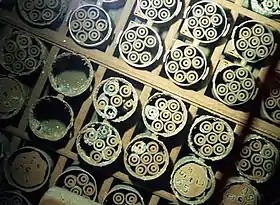
On June 25, 1988, the Hanford site was divided into four areas and proposed for inclusion on the National Priorities List.[140] On May 15, 1989, the Washington Department of Ecology, the United States Environmental Protection Agency, and the Department of Energy entered into the Tri-Party Agreement, which provides a legal framework for environmental remediation at Hanford.[141] As of 2014 the agencies are engaged in the world's largest environmental cleanup, with many challenges to be resolved in the face of overlapping technical, political, regulatory, and cultural interests. The cleanup effort is focused on three outcomes: restoring the Columbia River corridor for other uses, converting the central plateau to long-term waste treatment and storage, and preparing for the future.[142]
The weapons production reactors were decommissioned at the end of the Cold War, and decades of manufacturing left behind 53 million US gallons (200,000 m3) of high-level radioactive waste[143] stored within 177 storage tanks, an additional 25 million cubic feet (710,000 m3) of solid radioactive waste, and areas of heavy technetium-99 and uranium contaminated groundwater beneath three tank farms on the site as well as the potential for future groundwater contamination beneath currently contaminated soils.[143] In 2011, DOE, the federal agency charged with overseeing the site, "interim stabilized" 149 single-shell tanks by pumping nearly all of the liquid waste out into 28 newer double-shell tanks. Solids, known as salt cake and sludge, remained. The DOE later found water intruding into at least 14 single-shell tanks and that one of them had been leaking about 640 US gallons (2,400 l; 530 imp gal) per year into the ground since about 2010. In 2012, the DOE also discovered a leak from a double-shell tank caused by construction flaws and corrosion in the tank's bottom, and that 12 other double-shell tanks had similar construction flaws. Since then, the DOE began monitoring single-shell tanks monthly and double-shell tanks every three years. The DOE also changed the methods by which they monitored the tanks. In March 2014, the DOE announced further delays in the construction of the Waste Treatment Plant, which will affect the schedule for removing waste from the tanks.[144] Intermittent discoveries of undocumented contamination have slowed the pace and raised the cost of cleanup.[145]
The cleanup effort is managed by the Department of Energy under the oversight of the two regulatory agencies. A citizen-led Hanford Advisory Board provides recommendations from community stakeholders, including local and state governments, regional environmental organizations, business interests, and Native American tribes.[146] Citing the 2014 Hanford Lifecycle Scope Schedule and Cost report, the 2014 estimated cost of the remaining Hanford clean up is $113.6 billion – more than $3 billion per year for the next six years, with a lower cost projection of approximately $2 billion per year until 2046.[147][148][149] About 11,000 workers are on site to consolidate, clean up, and mitigate waste, contaminated buildings, and contaminated soil[143] Originally scheduled to be complete within thirty years, the cleanup was less than half finished by 2008.[149] Of the four areas that were formally listed as Superfund sites on October 4, 1989, only one has been removed from the list following cleanup.[150] While major releases of radioactive material ended with the reactor shutdown in the 1970s and many of the most dangerous wastes are contained, there are continued concerns about contaminated groundwater headed toward the Columbia River and about workers' health and safety.[149]
The most significant challenge at Hanford is stabilizing the 53,000,000 US gallons (200,000,000 l; 44,000,000 imp gal) of high-level radioactive waste stored in 177 underground tanks. By 1998, about a third of these tanks had leaked waste into the soil and groundwater.[151] As of 2008, most of the liquid waste had been transferred to more secure double-shelled tanks; however, 2,800,000 US gallons (11,000,000 l; 2,300,000 imp gal) of liquid waste, together with 27,000,000 US gallons (100,000,000 l; 22,000,000 imp gal) of salt cake and sludge, remains in the single-shelled tanks.[143] DOE lacks information about the extent to which the 27 double-shell tanks may be susceptible to corrosion. Without determining the extent to which the factors that contributed to the leak in AY-102 were similar to the other 27 double-shell tanks, DOE cannot be sure how long its double-shell tanks can safely store waste.[144] That waste was originally scheduled to be removed by 2018. As of 2008, the revised deadline was 2040.[149] Nearby aquifers contain an estimated 270,000,000,000 US gallons (1.0×1012 l; 2.2×1011 imp gal) of contaminated groundwater as a result of the leaks.[152] As of 2008, 1,000,000 US gallons (3,800,000 l; 830,000 imp gal) of radioactive waste is traveling through the groundwater toward the Columbia River. This waste is expected to reach the river in 12 to 50 years if cleanup does not proceed on schedule.[143] The site includes 25 million cubic feet (710,000 m3) of solid radioactive waste.[152]
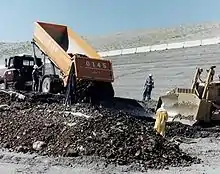
Under the Tri-Party Agreement, lower-level hazardous wastes are buried in huge lined pits that will be sealed and monitored with sophisticated instruments for many years. Disposal of plutonium and other high-level wastes is a more difficult problem that continues to be a subject of intense debate. As an example, plutonium-239 has a half-life of 24,100 years, and a decay of ten half-lives is required before a sample is considered to cease its radioactivity.[153][154] In 2000, the Department of Energy awarded a $4.3 billion contract to Bechtel, a San Francisco-based construction and engineering firm, to build a vitrification plant to combine the dangerous wastes with glass to render them stable. Construction began in 2002. The plant was originally scheduled to be operational by 2011, with vitrification completed by 2028.[149][155][156] According to a 2012 study by the General Accounting Office, there were a number of serious unresolved technical and managerial problems.[157] As of 2013 estimated costs were $13.4 billion with commencement of operations estimated to be in 2022 and about 3 decades of operation.[158]
In May 2007, state and federal officials began closed-door negotiations about the possibility of extending legal cleanup deadlines for waste vitrification in exchange for shifting the focus of the cleanup to urgent priorities, such as groundwater remediation. Those talks stalled in October 2007. In early 2008, a $600 million cut to the Hanford cleanup budget was proposed. Washington state officials expressed concern about the budget cuts, as well as missed deadlines and recent safety lapses at the site, and threatened to file a lawsuit alleging that the Department of Energy was in violation of environmental laws.[149] They appeared to step back from that threat in April 2008 after another meeting of federal and state officials resulted in progress toward a tentative agreement.[159]
During excavations from 2004 to 2007, a sample of purified plutonium was uncovered inside a safe in a waste trench, and has been dated to about the 1940s, making it the second-oldest sample of purified plutonium known to exist. Analyses published in 2009 concluded that the sample originated at Oak Ridge, and was one of several sent to Hanford for optimization tests of the T-Plant until Hanford could produce its own plutonium. Documents refer to such a sample, belonging to "Watt's group", which was disposed of in its safe when a radiation leak was suspected.[160][161]
Some of the radioactive waste at Hanford was supposed to be stored in the planned Yucca Mountain nuclear waste repository,[162] but after that project was suspended, Washington State sued, joined by South Carolina.[163] Their first suit was dismissed in July 2011.[164] In a subsequent suit, federal authorities were ordered to either approve or reject plans for the Yucca Mountain storage site.[165]
A potential radioactive leak was reported in 2013; the cleanup was estimated to have cost $40 billion, with $115 billion more required.[166]
A radioactive waste leak was reported in April 2021, as observed by the United States Department of Energy.[167]
Hanford organizations
The Hanford site operations were initially directed by Colonel Franklin Matthias of the U.S. Army Corps of Engineers. Postwar the Atomic Energy Commission took over, and then the Energy Research and Development Administration. Since 1977, Hanford operations are directed by the U.S. Department of Energy. It has been operated under government contract by various private companies over the years, as summarized in the table through 2000.[168]
| Year begun | Month | Organization | Responsibility | Remarks |
|---|---|---|---|---|
| 1942 | December 12 | U.S. Army Corps of Engineers | Lead U.S. Government entity | Held role until January 1, 1947 |
| 1942 | December 12 | E. I. DuPont de Nemours & Company (DuPont) | All site activities | Initial Hanford site contractor |
| 1946 | September 1 | General Electric Company (GE) | All site activities | Replaced DuPont |
| 1947 | January 1 | Atomic Energy Commission | Lead U.S. Government entity | Replaced U.S. Army Corps of Engineers |
| 1953 | May 15 | Vitro Engineers | Hanford Engineering Services | Assumed GEs new facility design role |
| 1953 | June 1 | J. A. Jones Construction | Hanford Construction Services | Assumed GEs construction role |
| 1965 | January 1 | U.S. Testing | Environmental & bioassay testing | Assumed GEs environmental and bioassay testing role |
| 1965 | January 4 | Battelle Memorial Institute | Pacific Northwest Laboratory (PNL) | Assumed GE's laboratory operations – subsequently renamed Pacific Northwest National Laboratory |
| 1965 | July 1 | Computer Sciences Corporation (CSC) | Computer services | New scope |
| 1965 | August 1 | Hanford Occupational Health Foundation | Industrial Medicine | Assumed GE's industrial medicine role |
| 1965 | September 10 | Douglas United Nuclear | Single pass reactor operations & fuel fabrication | Assumed part of GE's reactor operations |
| 1966 | January 1 | Isochem | Chemical processing | Assumed GE's chemical processing operations |
| 1966 | March 1 | ITT Federal Support Services, Inc. | Support services | Assumed |
| 1967 | July 1 | Douglas United Nuclear | N Reactor operation | Assumed remainder of GE's reactor operations |
| 1967 | September 4 | Atlantic Richfield Hanford Company | Chemical Processing | Replaced Isochem |
| 1967 | August 8 | Hanford Environmental Health Foundation | Industrial Medicine | Name change only |
| 1970 | February 1 | Westinghouse Hanford Company | Hanford Engineering Development Laboratory | Spun off from PNL with mission to build the Fast Flux Test Facility |
| 1971 | September | ARHCO | Support Services | Replaces ITT/PSS |
| 1973 | April | United Nuclear Industries, Inc. | All production reactor operations | Name change from Douglas United Nuclear only |
| 1975 | January 1 | Energy Research and Development Administration (ERDA) | Lead U.S. Government entity | Replaced AEC – managed site until October 1, 1977 |
| 1975 | October 1 | Boeing Computer Services (BCS) | Computer services | Replaced CSC |
| 1977 | October 1 | U.S. Department of Energy (DOE) | Lead U.S. Government Agency | Replaced ERDA – manages site presently |
| 1977 | October 1 | Rockwell Hanford Operations (RHO) | Chemical Processing & Support Services | Replaces ARCHO |
| 1981 | June | Braun Hanford Company (BHC) | Architect & Engineering Services | Replaces Vitro |
| 1982 | March | Kaiser Engineering Hanford (KEH) | Architect & Engineering Services | Replaces BHC |
| 1987 | March 1 | KEH | Construction | Consolidated contract includes former J. A. Jones work |
| 1987 | June 29 | WHC | Site management & operations | Consolidated contract includes former RHO, UNC & KEH work. |
| 1996 | October 1 | Fluor Daniel Hanford, Inc. (FDH) | Site management & operations | FDH is integrating contractor with 13 subcontracted companies |
| 2000 | February 7 | Fluor Hanford | Site cleanup operations | Transition to site cleanup (13 Fluor subcontractors held various roles) |
| 2000 | December 11 | Bechtel National, Inc. | Engineering, construction, and commissioning of the Waste Treatment Plant | |
| 2008 | October 1 | Ch2M Hill Plateau Remediation Company | Central plateau cleanup and closure | |
| 2009 | April 8 | Washington Closure Hanford | River corridor cleanup and closure | |
| 2009 | May 26 | Mission Support Alliance | Site infrastructure and services | Consolidated services contract |
| 2009 | October 1 | Washington River Protection Solutions | Tank Farm operations |
Other divisions of the site (historical)
- Plutonium Finishing Plant (PFP) – made plutonium metal for use in weapons[169]
- B Plant, S Plant, T Plant – processing, separation, and extraction of various chemicals and isotopes[170][171]
- Health Instruments Section – an attempt to keep workers and the environment safe[171]
- REDOX Plant / C Plant – recovered wasted uranium from World War II processes[171]
- Experimental Animal Farm and Aquatic Biology Laboratory[171]
- Technical Center – radiochemistry, physics, metallurgy, biophysics, radioactive sewer, neutralization, metal fab, fuels manufacturing[171]
- Tank Farms – storage of liquid nuclear waste[171]
- Metal Recovery Plant / U Plant – recover uranium from tank farms[171]
- Uranium Trioxide Plant (aka Uranium Oxide Plant aka UO3 Plant) – took output from other plants (i.e., liquid uranyl nitrate hexahydrate from U plant and PUREX plant), made uranium trioxide powder[170][171][172][173][174][175][176]
- Plutonium-Uranium Extraction Plant / PUREX Plant – extracted useful material from spent fuel waste[170][171]
- Plutonium Recycle Test Reactor (PRTR) – experimented with alternative fuel mixtures[169][171][177][178]
- Plutonium Fuels Pilot Plant (PFPP) – see PRTR
Historic photos
 Cooling water retention basins at the F-Reactor
Cooling water retention basins at the F-Reactor Underground tank farm with 12 of the site's 177 waste storage tanks
Underground tank farm with 12 of the site's 177 waste storage tanks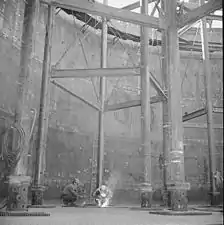 Inside one of the waste storage tanks
Inside one of the waste storage tanks Inside the PUREX facility
Inside the PUREX facility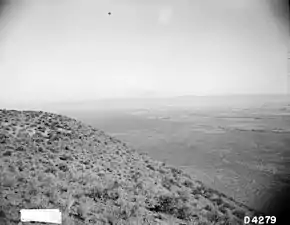 View of the central plateau from Rattlesnake Mountain
View of the central plateau from Rattlesnake Mountain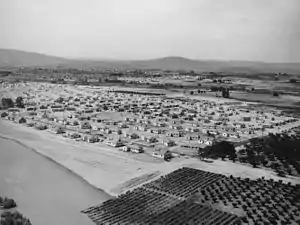 The government town of Richland in the early days of the site
The government town of Richland in the early days of the site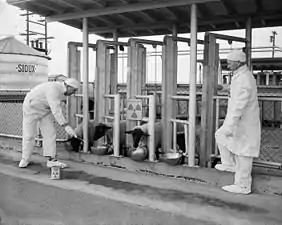 Hanford scientists feeding radioactive food to sheep
Hanford scientists feeding radioactive food to sheep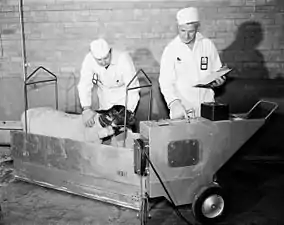 Testing a sheep's thyroid for radiation
Testing a sheep's thyroid for radiation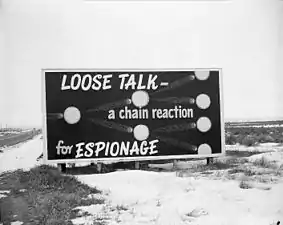 Cold War-era billboard
Cold War-era billboard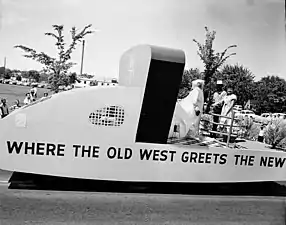 "Atomic Frontier Days" parade in Richland
"Atomic Frontier Days" parade in Richland The Fast Flux Test Facility
The Fast Flux Test Facility
See also
- Lists of nuclear disasters and radioactive incidents
- Timeline of nuclear weapons development
- United States naval reactors – Decommissioned power plants storage
Notes
- "Hanford Site: Hanford Overview". United States Department of Energy. Archived from the original on May 11, 2012. Retrieved February 13, 2012.
- "Science Watch: Growing Nuclear Arsenal". The New York Times. April 28, 1987. Retrieved January 29, 2007.
- "The Columbia River at Risk: Why Hanford Cleanup is Vital to Oregon". oregon.gov. August 1, 2007. Archived from the original on June 2, 2010. Retrieved March 31, 2008.
- Hanford Cultural Resources Program 2002, p. 1.12.
- United States Department of Energy 2022, p. 1-6.
- Seelye, Katharine (June 10, 2000). "Gore Praises Move to Aid Salmon Run". The New York Times. Retrieved January 29, 2007.
- "Site Map Area and Description". Columbia Riverkeepers. Archived from the original on February 8, 2007. Retrieved January 29, 2007.
- Lewis, Mike (April 19, 2002). "In strange twist, Hanford cleanup creates latest boom". Seattle Post-Intelligencer. Retrieved January 29, 2007.
- Gerber 2002, p. 13.
- "Hanford AEC, Washington (453444)". Western Regional Climate Center. Retrieved April 27, 2016.
- Markell, Joanna (February 10, 2022), "Washington officially has a new all-time maximum temperature record: 120 degrees", Yakima Herald-Republic
- "Hanford Reach National Monument". HistoryLink.org: The Online Encyclopedia of Washington State History. Retrieved January 29, 2007.
- Hanford Island Archaeological Site (NRHP #76001870) and Hanford North Archaeological District (NRHP #76001871). "National Register Information System". National Register of Historic Places. National Park Service. January 23, 2007. (See also the commercial site National Register of Historic Places.)
- Gerber 1992, p. 1.
- Gerber 2002, pp. 16–22.
- Gerber 1992, p. 2.
- Hanford Cultural Resources Program 2002, p. 1.10.
- Jones 1985, p. 77.
- Manhattan District 1947a, p. 1.1.
- Hewlett & Anderson 1962, p. 105.
- Groves 1983, pp. 42–44.
- Jones 1985, p. 97.
- Hounshell & Smith 1988, p. 339.
- Groves 1983, pp. 58–59.
- Groves 1983, pp. 69–70.
- Groves 1983, pp. 69–71.
- Groves 1983, pp. 70–71.
- Thayer 1996, p. 26.
- Groves 1983, pp. 70–74.
- "Gilbert Church's Interview". Manhattan Project Voices. Retrieved October 7, 2022.
- Manhattan District 1947c, pp. 2.4–2.6.
- Gerber 1992, p. 6.
- Groves 1983, pp. 74–75.
- Oldham, Kit (March 5, 2003). "Construction of massive plutonium production complex at Hanford begins in March 1943". History Link. Retrieved April 6, 2008.
- Manhattan District 1947d, p. 4.1.
- "Second War Powers Act 56 Stat. 176 (1942)". US Government. Retrieved October 10, 2022.
- Manhattan District 1947d, pp. 3.1–3.3.
- Manhattan District 1947d, pp. 4.1–4.2.
- Jones 1985, pp. 331–332.
- Jones 1985, p. 334.
- Groves 1983, pp. 76–77.
- Manhattan District 1947d, pp. 4.12–4.13, 4.20–4.21.
- Manhattan District 1947d, pp. 4.25–4.26.
- Jones 1985, pp. 335–336.
- Jones 1985, p. 337.
- Jones 1985, pp. 337–338.
- Manhattan District 1947d, p. 5.3.
- Department of Energy: Hanford. "Department of Energy's Tribal Program: The DOE Tribal Program at Hanford". DOE Hanford. Retrieved April 20, 2014.
- Brown 2013, pp. 33–36.
- Hanford Cultural Resources Program 2002, pp. 1.12–1.13.
- "Needed by E. I. duPont de Nemours & Company for Pacific Northwest (advertisement)". Milwaukee Sentinel. June 6, 1944. pp. 1–5. Retrieved March 25, 2013.
- Jones 1985, pp. 450–451.
- Manhattan District 1947e, p. 4.14.
- Findlay & Hevly 1995, pp. 16–19.
- Brown 2013, p. 27.
- Jones 1985, p. 455.
- Manhattan District 1947e, pp. 5.6–5.10.
- Hales 1997, pp. 95–99.
- Findlay & Hevly 1995, pp. 36–39.
- Gerber 1992, pp. 35–36.
- Manhattan District 1947f, pp. 2.1–2.2.
- Manhattan District 1947c, pp. 5.48–5.49.
- Hanford Cultural Resources Program 2002, pp. 1.22–1.27.
- Hanford Cultural Resources Program 2002, pp. 1.15, 1.30.
- Harvey 1990, p. 11.
- "B Reactor". Hanford Site. Retrieved October 30, 2022.
- Manhattan District 1947c, p. 2.12.
- Manhattan District 1947e, pp. 5.63–5.65.
- Manhattan District 1947c, p. 5.69.
- Jones 1985, p. 267.
- Shurkin, Joel (March 21, 2016). "Japanese Balloon Attack Almost Interrupted Building First Atomic Bombs". Inside Science. Retrieved October 26, 2022.
- Carlisle & Zenzen 2019, pp. 41–42.
- Manhattan District 1947f, pp. 2.7–2.8.
- Hewlett & Anderson 1962, pp. 219–222.
- Gerber 1996, p. 4-1.
- Groueff 1967, pp. 292–296.
- Hanford Cultural Resources Program 2002, pp. 1.21–1.23.
- Findlay & Hevly 1995, p. 50.
- Manhattan District 1947f, p. 5.5.
- Findlay & Hevly 1995, pp. 50–51.
- Hanford Cultural Resources Program 2002, p. 1.27.
- Hanford Cultural Resources Program 2002, p. 1.22.
- Groves 1983, p. xv.
- Gerber 2002, p. 295.
- Cullum 1950, p. 897.
- Jones 1985, p. 584.
- Hewlett & Anderson 1962, p. 629.
- Jones 1985, pp. 591–592.
- Hewlett & Anderson 1962, p. 420.
- Carlisle & Zenzen 2019, p. 54.
- Jones 1985, pp. 599–600.
- Manhattan District 1947e, pp. 11.4, B56.
- Jones 1985, pp. 592–593.
- Carlisle & Zenzen 2019, pp. 55–56.
- Manhattan District 1947f, pp. 4.19–4.25.
- Hanford Cultural Resources Program 2002, p. 1.42–1.45.
- "Historical use of thorium at Hanford" (PDF). hanfordchallenge.org. Archived from the original (PDF) on May 12, 2013. Retrieved February 7, 2015.
- "Chronology of Important FOIA Documents: Hanford's Semi-Secret Thorium to U-233 Production Campaign" (PDF). hanfordchallenge.org. Archived from the original (PDF) on October 15, 2012. Retrieved February 7, 2015.
- "Questions and Answers on Uranium-233 at Hanford" (PDF). radioactivist.org. Retrieved February 7, 2015.
- "Hanford Radioactivity in Salmon Spawning Grounds" (PDF). clarku.edu. Retrieved February 7, 2015.
- "Hanford nuclear workers enter site of worst contamination accident". Billings Gazette. Associated Press. June 3, 2005. Archived from the original on October 13, 2007. Retrieved March 6, 2017.
- "Cocooning Hanford Reactors". City of Richland. December 2, 2003. Archived from the original on June 11, 2008. Retrieved January 31, 2008.
- NRHP site #92000245. "National Register Information System". National Register of Historic Places. National Park Service. January 23, 2007. (See also the commercial site National Register of Historic Places.)
- "B-Reactor Museum Association". B Reactor Museum Association. January 2008. Retrieved January 29, 2007.
- "Big Step Toward B Reactor Preservation". KNDO/KNDU News. March 12, 2008. Archived from the original on June 10, 2008. Retrieved April 6, 2008.
- Chemical & Engineering News Vol. 86 No. 35, September 1, 2008, "Hanford's B Reactor gets LANDMARK Status", p. 37
- "National Historic Landmarks Program – B Reactor". National Park Service. August 19, 2007. Retrieved January 5, 2009.
- Boyle, Rebecca (2017). "Greetings from Isotopia". Distillations. 3 (3): 26–35. Retrieved June 14, 2018.
- Richard, Terry (November 10, 2015). "Washington's Hanford becomes part of national historical park". The Oregonian. Retrieved April 4, 2016.
- "Plutonium: the first 50 years: United States plutonium production, acquisition, and utilization from 1944 through 1994". U.S. Department of Energy. Retrieved January 29, 2007.
- Potter, Robert F. "Preserving the Hanford B-Reactor: A Monument to the Dawn of the Nuclear Age". APS Physics. Retrieved June 19, 2018.
- "D and DR Reactors". Hanford.gov. Retrieved June 19, 2018.
- Cary, Annette (October 22, 2014). "Hanford's F Reactor passes 5-year inspection". Tri-City Herald. Retrieved June 19, 2018.
- "H Reactor". Hanford.gov. Retrieved June 19, 2018.
- "ISS Reactors". Hanford.gov. Retrieved June 19, 2018.
- Cary, Annette (July 4, 2015). "Looking inside Hanford's cocooned reactors". Tri-City Herald. Retrieved June 19, 2018.
- Office of Environmental Management (January 30, 2018). "Hanford Workers Enter Reactor to Prepare for Cocooning". Department of Energy. Retrieved June 19, 2018.
- Office of Environmental Management (June 14, 2012). "N Reactor Placed In Interim Safe Storage: Largest Hanford Reactor Cocooning Project Now Complete". Department of Energy. Retrieved June 19, 2018.
- Cary, Annette (June 3, 2009). "Fast Flux Test Facility shutdown completed at Hanford". Hanford News. Archived from the original on November 17, 2010.
- Twilley, Nicola. "Gravitational Waves Exist: The Inside Story of How Scientists Finally Found Them". The New Yorker. ISSN 0028-792X. Retrieved February 12, 2016.
- Abbott, B. P.; et al. (2016). "Observation of Gravitational Waves from a Binary Black Hole Merger". Phys. Rev. Lett. 116 (6): 061102. arXiv:1602.03837. Bibcode:2016PhRvL.116f1102A. doi:10.1103/PhysRevLett.116.061102. PMID 26918975. S2CID 119286014.
- Naeye, Robert (February 11, 2016). "Gravitational Wave Detection Heralds New Era of Science". Sky and Telescope. Retrieved February 12, 2016.
- Castelvecchi, Davide; Witze, Alexandra (February 11, 2016). "Einstein's gravitational waves found at last". Nature News. doi:10.1038/nature.2016.19361. S2CID 182916902. Retrieved February 11, 2016.
- "Submarine". navy.memorieshop.com. Archived from the original on March 9, 2015. Retrieved February 7, 2015.
- "Tour Information". United States Department of Energy / Hanford.gov. Retrieved June 15, 2018.
- "Hanford Emergency Information". hanford.gov. U.S. Department of Energy Richland Operations. May 9, 2017. Archived from the original on May 10, 2017. Retrieved May 9, 2017.
- "An Overview of Hanford and Radiation Health Effects". Hanford Health Information Network. Archived from the original on January 6, 2010. Retrieved January 29, 2007.
- "Radiation Flowed 200 Miles to Sea, Study Finds". The New York Times. July 17, 1992. Retrieved January 29, 2007.
- Gerber 2002, pp. 78–80.
- Martin, Hugo (August 13, 2008). "Nuclear site now a tourist hot spot". The Los Angeles Times.
- McClure, Robert (May 21, 2005). "Downwinders' court win seen as 'great victory'". Seattle Post-Intelligencer. Retrieved January 29, 2007.
- "Radiological Aspects (water sanitation)" (PDF). www.who.int. WHO.
- "Hanford Site National Environmental Policy Act (NEPA) Characterization" (PDF). Pacific Northwest National Laboratory. September 2005. PNNL-6415 Rev. 17.
- "Tank storing radioactive waste leaking in Washington". CNN. February 16, 2013. Retrieved February 15, 2013.
- "Washington Gov. Inslee's office: 6 more tanks at Hanford site are leaking radioactive waste". Breaking News. Retrieved February 22, 2013.
- "Gov: 6 underground Hanford nuclear tanks leaking | Inquirer News". Newsinfo.inquirer.net. March 23, 2004. Retrieved February 23, 2013.
- Johnson, Eric (February 1, 2013). "Radioactive waste leaking from six tanks at Washington state nuclear site". Reuters. Retrieved February 23, 2013.
- Nicholas K. Geranios (November 19, 2014). "Washington to sue over nuclear site's tank vapors". Associated Press. Retrieved December 19, 2014.
- "OSHA orders Hanford nuclear facility contractor to reinstate worker fired for raising environmental safety concerns". OSHA. August 20, 2014.
- "Hanford – Washington Superfund site". U.S. EPA. Retrieved February 3, 2010.
- Schneider, Keith (February 28, 1989). "Agreement for a Cleanup at Nuclear Site". The New York Times. Retrieved January 30, 2008.
- "Hanford Site Tour Script" (PDF). United States Department of Energy. October 2007. Archived from the original (PDF) on February 27, 2008. Retrieved January 29, 2007.
- "Hanford Quick Facts". Washington Department of Ecology. Archived from the original on June 24, 2008. Retrieved January 19, 2010.
- GAO (November 25, 2014). "Condition of Tanks May Further Limit DOE's Ability to Respond to Leaks and Intrusions – Highlights". GAO Highlights. U.S. GAO (GAO-15-40). Retrieved December 22, 2014.
- Stang, John (December 21, 2010). "Spike in radioactivity a setback for Hanford cleanup". Seattle Post-Intelligencer.
- "Hanford Site: Hanford Advisory Board". United States Department of Energy. Retrieved February 14, 2012.
- Tri-Party Agreement: Department of Energy, Washington State Department of Ecology and the U.S. Environmental Protection Agency (February 2014). "2014 Hanford Lifecycle Scope, Schedule and Cost Report" (PDF). DOE, WSDE, EPA. Retrieved April 20, 2014.
- Cary, Annette (February 21, 2014). "New Hanford clean up price tag is $113.6B". Yakima Herald. Archived from the original on April 20, 2014. Retrieved April 20, 2014.
- Stiffler, Lisa (March 20, 2008). "Troubled Hanford cleanup has state mulling lawsuit". Seattle Post-Intelligencer.
- "Hanford 1100-Area (USDOE) Superfund site". U.S. EPA. Retrieved February 3, 2010.
- Wald, Matthew (January 16, 1998). "Panel Details Management Flaws at Hanford Nuclear Waste Site". The New York Times. Archived from the original on June 11, 2008. Retrieved January 29, 2007.
- Wolman, David (April 2007). "Fission Trip". Wired Magazine. p. 78.
- Hanson, Laura A. (November 2000). "Radioactive Waste Contamination of Soil and Groundwater at the Hanford Site" (PDF). University of Idaho. Archived from the original (PDF) on February 27, 2008. Retrieved January 31, 2008.
- Gephart, Roy (2003). Hanford: A Conversation About Nuclear Waste and Cleanup. Columbus, OH: Battelle Press. ISBN 1-57477-134-5.
- Dininny, Shannon (September 8, 2006). "Hanford plant now $12.2 billion". Seattle Post-Intelligencer. Retrieved January 29, 2007.
- The Economist, "Nuclear waste: From bombs to $800 handbags", March 19, 2011, p. 40.
- "Hanford Waste Treatment Plant: DOE Needs to Take Action to Resolve Technical and Management Challenges". General Accounting Office. December 19, 2012. GAO-13-38. Retrieved May 9, 2013.
- Valerie Brown (May 9, 2013). "Hanford Nuclear Waste Cleanup Plant May Be Too Dangerous: Safety issues make plans to clean up a mess left over from the construction of the U.S. nuclear arsenal uncertain". Scientific American. Retrieved May 9, 2013.
The Vit Plant was supposed to start operating in 2007 and is now projected to begin in 2022. Its original budget was $4.3 billion and is now estimated at $13.4 billion.
- Stiffler, Lisa (April 3, 2008). "State steps back from brink of Hanford suit". Seattle Post-Intelligencer. Retrieved May 8, 2008.
- Chemical & Engineering News: Antique Plutonium: Manhattan Project-era plutonium is found in a glass jug during Hanford Site cleanup(subscription required)
- Annette Cary (January 25, 2009). "Historic plutonium found in safe at Hanford". Seattle Post-Intelligencer.
- Shannon Dininny (April 14, 2010). "Washington sues to keep Yucca alive". The Spokesman-Review. Associated Press. Retrieved March 14, 2012.
- "Appeals court rejects Yucca Mountain lawsuit". World Nuclear News. April 7, 2011. Retrieved March 14, 2012.
- Chad Mills (July 2, 2011). "Aiken County still optimistic after Yucca Mountain lawsuit dismissed in federal court". Tri-City Herald. Archived from the original on June 18, 2013. Retrieved March 14, 2012.
- Daly, Matthew (August 13, 2013). "Home> Politics Appeals Court: Obama Violating Law on Nuke Site". ABC News. Retrieved August 14, 2013.
- "Possible radioactive leak into soil at Hanford". CBS News. June 21, 2013.
- "Nuclear waste tank at Hanford site in Washington state may be leaking". Oregon Live. April 29, 2021. Retrieved April 29, 2021.
- Briggs, J. D. (March 22, 2001). "Historical Time Line and Information about the Hanford Site, Richland, Washington" (PDF). Pacific Northwest National Laboratory. Retrieved February 14, 2012.
- Lini, D. C.; L. H. Rodgers / SAIC / FH (March 2002). Plutonium Finishing Plant Plutonium- Uranium Oxide (PDF) (Report). US DOE. doi:10.2172/808358. Retrieved October 1, 2009.
- "222-S Hanford Site". Advanced Technologies and Laboratories Intl. Archived from the original on May 31, 2009. Retrieved October 1, 2009.
- Gerber, M. S. (February 2001). History of Hanford Site Defense Production (Brief) (PDF) (Report). Fluor Hanford / US DOE. Retrieved October 1, 2009.
- Freer, Brian; Charles Conway (June 2002). History of the Plutonium Production Facilities at the Hanford Site Historic District, 1943–1990. Section 4 – Chemical Separations (PDF). US DOE. doi:10.2172/807939.
- Brevick; Stroup; Funk; et al. (1997). "Supporting Document for the Historical Tank Content Estimate for SY-Tank Farm". US DOE. Retrieved October 5, 2009.
- Johnson; et al. (1994). Historical records of radioactive contamination in biota at the 200 Areas of the Hanford Site (Report). US DOE. doi:10.2172/10191138. Retrieved October 5, 2009.
- Carbaugh, E. H.; Bihl, D. E.; MacLellan, J. A. (January 1, 2003). "Methods and Models of the Hanford Internal Dosimetry Program, PNNL-MA-860" (PDF). Retrieved October 5, 2009.
- Mecca, J. E. (June 2000). Executive Summary Hanford Recycled Uranium Project (PDF). US DOE. doi:10.2172/803918. Archived from the original (PDF) on September 23, 2008. Retrieved October 5, 2009.
- Nuclear Engineering International (January 23, 2014). "Hanford removes plutonium test reactor". neimagazine.com. Retrieved January 24, 2014.
- "Massive Hanford Test Reactor Removed – Plutonium Recycle Test Reactor removed from Hanford's 300 Area". Department of Energy. January 22, 2014. Archived from the original on January 29, 2014. Retrieved January 24, 2014.
References
- Brown, Kate (2013). Plutopia: Nuclear Families, Atomic Cities, and the Great Soviet and American Plutonium Disasters. Oxford: University of Oxford Press. ISBN 978-0-19-985576-6. OCLC 813540523.
- Carlisle, Rodney P.; Zenzen, Joan M. (2019). Supplying the Nuclear Arsenal: American Production Reactors, 1942-1992. Baltimore, Maryland: Johns Hopkins University Press. ISBN 978-14214-3590-9. OCLC 1325858668.
- Cullum, George W. (1950). Biographical Register of the Officers and Graduates of the US Military Academy at West Point New York since its Establishment in 1802: Supplement Volume IX 1940–1950. Chicago, Illinois: R. R. Donnelly and Sons, The Lakeside Press. Retrieved October 13, 2015.
- Findlay, John; Hevly, Bruce (1995). Nuclear Technologies and Nuclear Communities: A History of Hanford and the Tri-Cities, 1943–1993 (PDF). Seattle, Washington: Hanford History Project, Center for the Study of the Pacific Northwest, University of Washington. Retrieved October 12, 2022.
- Gerber, Michele (1992). Legend and Legacy: Fifty Years of Defense Production at the Hanford Site. Richland, Washington: Westinghouse Hanford Company. doi:10.2172/10144167. OSTI 10144167.
- Gerber, Michele (June 1996). The Plutonium Production Story at the Hanford Site: Processes and Facilities History (PDF) (Report). Richland, Washington: Westinghouse. WHC-MR-0521. Retrieved October 29, 2022.
- Gerber, Michele (2002). On the Home Front: The Cold War Legacy of the Hanford Nuclear Site (2nd ed.). Lincoln, Nebraska: University of Nebraska Press. ISBN 978-0-8032-7101-2. OCLC 46959336.
- Groueff, Stephane (1967). Manhattan Project: The Untold Story of the Making of the Atomic Bomb. Boston: Little, Brown and Company. OCLC 179905.
- Groves, Leslie (1983) [1992]. Now It Can Be Told: The Story of the Manhattan Project. New York: Da Capo Press. ISBN 0-306-80189-2. OCLC 9132112.
- Hales, Peter Bacon (1997). Atomic Spaces: Living on the Manhattan Project. Urbana and Chicago: University of Illinois Press. ISBN 978-0-252-02296-8. OCLC 36292920.
- Hanford Cultural Resources Program (2002). Hanford Site Historic District: History of the Plutonium Production Facilities, 1943–1990. Columbus, Ohio: Battelle Press. doi:10.2172/807939. ISBN 978-1-57477-133-6. OCLC 50844404. OSTI 807939.
- Harvey, David (1990). History of the Hanford Site 1943–1990 (PDF). Hanford, Washington: Pacific Northwest National Laboratory. Retrieved November 6, 2015.
- Hewlett, Richard G.; Anderson, Oscar E. (1962). The New World, 1939–1946 (PDF). University Park: Pennsylvania State University Press. ISBN 0-520-07186-7. OCLC 637004643. Retrieved March 26, 2013.
- Hewlett, Richard G.; Duncan, Francis (1969). Atomic Shield, 1947–1952 (PDF). A History of the United States Atomic Energy Commission. University Park: Pennsylvania State University Press. ISBN 0-520-07187-5. OCLC 3717478. Retrieved November 5, 2022.
- Hounshell, David A.; Smith, John Kenly Jr. (1988). Science and Corporate Strategy: DuPont R&D, 1902–1980. Cambridge: Cambridge University Press. ISBN 978-0-521-02852-3. OCLC 16982414.
- Jones, Vincent (1985). Manhattan: The Army and the Atomic Bomb (PDF). United States Army in World War II. Washington, D.C.: United States Army Center of Military History. OCLC 10913875. Archived from the original (PDF) on October 7, 2014. Retrieved August 25, 2013.
- Manhattan District (1947a). General Features (PDF). Manhattan District History, Book IV – Plutonium (X-10) Project. Vol. 1. Washington, D.C.: Manhattan District. Retrieved October 8, 2022.
- Manhattan District (1947c). Design (PDF). Manhattan District History, Book IV – Plutonium (X-10) Project. Vol. 3. Washington, D.C.: Manhattan District. Retrieved October 8, 2022.
- Manhattan District (1947d). Land Acquisition (PDF). Manhattan District History, Book IV – Plutonium (X-10) Project. Vol. 4. Washington, D.C.: Manhattan District. Retrieved October 8, 2022.
- Manhattan District (1947e). Construction (PDF). Manhattan District History, Book IV – Plutonium (X-10) Project. Vol. 5. Washington, D.C.: Manhattan District. Retrieved October 8, 2022.
- Manhattan District (1947f). Operation (PDF). Manhattan District History, Book IV – Plutonium (X-10) Project. Vol. 6. Washington, D.C.: Manhattan District. Retrieved October 8, 2022.
- Thayer, H. (1996). Management of the Hanford Engineer Works in World War II. New York: American Society of Civil Engineers Press. ISBN 978-0-7844-0160-6. OCLC 1342227256.
- United States Department of Energy (March 2022). Hanford Site: Fifth CERCLA Five-Year Review Report (PDF) (Report). Richland, Washington: United States Department of Energy. DOE/RL-2021-01. Retrieved October 6, 2022.
Further reading
- Findlay, John M.; Hevly, Bruce (2011). Atomic Frontier Days: Hanford and the American West. Seattle: University of Washington Press. ISBN 978-0-295-99097-2. OCLC 768474075. Explores the history of the Hanford nuclear reservation and the tri-cities of Richland, Pasco, and Kennewick, Washington
- Olson, Steve (2020). The Apocalypse Factory: Plutonium and the Making of the Atomic Age. New York: W. W. Norton & Company. ISBN 978-0-393-86835-7. OCLC 1252843981. Recounts the role of the Hanford site in creation and continuation of nuclear weapons
External links
- Official website
 Department of Energy.
Department of Energy. - Washington Department of Ecology – Nuclear Waste Program State agency that regulates Hanford cleanup.
- U.S. Environmental Protection Agency Federal agency that regulates Hanford cleanup.
- Historic American Engineering Record (HAER) documentation, filed under Richland, Benton County, WA:
- HAER No. WA-127, "D-Reactor Complex", 16 photos, 77 data pages, 2 photo caption pages
- HAER No. WA-127-A, "D-Reactor Complex, Deaeration Plant-Refrigeration Buildings", 13 photos, 2 photo caption pages
- HAER No. WA-127-B, "D-Reactor Complex, Tank Room and Process Pump House", 1 photo, 1 photo caption page
- HAER No. WA-127-C, "D-Reactor Complex, Process Water Pumphouse Annex", 2 photos, 1 photo caption page
- HAER No. WA-127-D, "D-Reactor Complex, Underwater Test Facility", 3 photos, 1 photo caption page
- HAER No. WA-128-A, "Plutonium Finishing Plant, Waste Incinerator Facility", 26 photos, 27 data pages, 2 photo caption pages
- HAER No. WA-129-A, "Reduction-Oxidation Complex, Plutonium Concentration Facility", 13 photos, 15 data pages, 2 photo caption pages
